
Butch Wilmore and Suni Williams stranded in space for nine months
2025-03-21 20:33- Astronauts Butch Wilmore and Suni Williams were stranded on the ISS for nine months due to technical issues with their spacecraft.
- They experienced several health challenges related to long-duration space travel, such as muscle atrophy and bone density loss.
- Their safe return from space initiated discussions on the implications of prolonged missions for future space exploration.
Express your sentiment!
Insights
In a remarkable incident, NASA astronauts Butch Wilmore and Suni Williams were stranded in space for nine months, significantly longer than their scheduled ten-day trip. This unexpected extension began after a test flight of Boeing's Starliner spacecraft on June 5, 2024, when propulsion issues rendered it unfit for their return. As a result, Wilmore and Williams had no choice but to continue their stay aboard the International Space Station (ISS) while plans were made for their eventual rescue by SpaceX. Their extended mission raised awareness about the physical and psychological challenges astronauts face during long-duration spaceflights. SpaceX, in conjunction with NASA, worked diligently to establish a safe plan for their return using a different Crew Dragon capsule. Despite the difficulties, the astronauts maintained their faith and resilience throughout this ordeal. Upon their return, they experienced physical challenges such as muscle atrophy and bone density loss due to the lack of gravity. Recovery included a 45-day rehabilitation program focused on rebuilding their muscle strength and adjusting to Earth's gravity again. This incident highlighted the potential risks of prolonged space missions and has sparked discussions on the impact of space travel on the human body. The heroes, after enduring months of uncertainty, ultimately returned safely home, providing valuable insights for future space exploration initiatives.
Contexts
Long-duration spaceflight presents unique challenges and effects on astronauts, primarily due to the microgravity environment and the associated physiological and psychological stressors. One of the most significant impacts of extended missions is on the skeletal system. Astronauts experience bone density loss, with studies indicating a reduction of around 1-2% per month in weight-bearing bones, which can lead to an increased risk of fractures and osteoporosis later in life. This bone loss occurs because the lack of gravitational force decreases the mechanical loading that bones typically experience on Earth, resulting in a net loss of bone mineral density. Space agencies have implemented countermeasures, such as resistance exercise protocols and nutritional interventions, to help mitigate these losses, but ongoing research is needed to determine the most effective strategies for long-term missions, such as those to Mars. Muscle atrophy is another consequence of prolonged space travel. In microgravity, the muscles used for standing, walking, and other daily activities are less engaged, leading to muscle mass reduction and strength loss. Similar to bone density, astronauts can lose as much as 20% muscle mass in the lower body during a six-month mission on the International Space Station. Resistance training has been shown to be beneficial in preserving muscle mass, but the effectiveness of these exercises is still being evaluated, particularly when adapted to the unique conditions of spaceflight. Moreover, any recovery after a return to Earth's gravity can be gradual, requiring a structured rehabilitation program to regain strength and endurance. Additionally, spaceflight can affect cardiovascular health. Prolonged exposure to microgravity can lead to cardiovascular deconditioning, manifesting as orthostatic intolerance and decreased cardiovascular efficiency. Astronauts may experience issues such as dizziness and fainting when returning to an upright position after landing, which is attributed to changes in blood volume distribution and reduced physical activity levels in space. Exercise regimens are crucial to maintain cardiovascular fitness, but the transient changes in cardiovascular responses pose significant challenges for long-duration missions where activities may be limited. The importance of monitoring cardiovascular parameters before, during, and after missions cannot be overstated, especially as missions advance farther from Earth. Psychological effects of long-duration spaceflight also pose critical issues. Extended periods of isolation and confinement can lead to stress, anxiety, and depression among crew members. The psychological well-being of astronauts is crucial for mission success, as their performance, cognitive function, and group dynamics can significantly impact mission outcomes. Conducting psychological assessments and providing mental health support have become integral parts of astronaut training and mission planning. Research into social cohesion and coping mechanisms in isolated environments offers valuable insights into how to sustain mental health during extended missions in space. NASA and other space agencies continue to explore innovative ways to support both physical and mental health, ensuring astronauts can endure the rigors of long-duration missions and return to Earth capable of transitioning back into daily life.